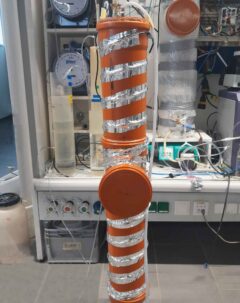The utilisation of CO2 from industrial waste gases by methanation is a process in which methane, a valuable product that can be widely distributed over the existing infrastructure and also stored over the long term like natural gas, is produced e.g. using renewable energy sources and hydrogen. The technology for industrial-scale methanation has already reached market readiness. The process usually requires high temperatures and achieves efficiency levels of around 80%. Another innovative concept currently being researched at TU Wien is the utilization of carbon dioxide via methanation in biogas at large sewage treatment plants. The gas also contains around 35% carbon dioxide in addition to around 65% methane. As with industrial methanation, this process also involves the use of electricity from renewable energy sources in order to split water into oxygen and hydrogen using electrolysis.
A biological process with high potential
Unlike the industrial process, a biological methanation process triggered by archaea is used here to convert the carbon dioxide, occurring at low temperatures (around 38 °C). One further advantage is that the processed raw gas already has a high methane content, meaning that the methane content in the biogas produced can be increased to almost 100 per cent. Sewage treatment plants that produce biogas also generally have the infrastructure required for gas storage and for further conversion into electricity. They are large consumers themselves, and this enables them to balance out peaks in supply and demand. The concept has three objectives: relieving the strain on the power grid by consuming energy locally, longer-term storage of surplus energy from photovoltaic and wind power and a reduction in CO2 emissions. The energy potential from implementation of biological methanation, which is particularly interesting for wastewater treatment plants with existing biogas production, is 220 GWh per year for Austria, or 3% of renewable electricity production or 1% of the total natural gas demand.
Research on biofilm reactors
The basic feasibility of the utilization of carbon dioxide via biological methanation in the biogas of wastewater treatment plants has already been trialed in a preliminary project. The procedural concept, which is based on the immobilisation of the bacterial biomass on carrier material, was developed in this context. The key factors for implementing the process are now being systematically investigated in the BioMeFilm project (biological methanation in a biofilm reactor), with the objective of developing the technology readiness level (TRL) even further. Key aspects of the project include an investigation into the nutrient and trace element requirements of the archaea, the long-term stability and efficiency of a biological methanation plant, and its behaviour in ‘on-off’ operation involving longer periods with no carbon dioxide or hydrogen being fed into the system. The project partners are the Institute of Water Quality and Resource Management at TU Wien and the Competence Center CHASE GmbH, which is involved in designing and configuring carrier material and reactor forms.
The project aims to create the process and procedural foundations required for a scale-up and large-scale technical implementation, in order to construct and operate biofilm methanation plants at the site of wastewater treatment plants with biogas production. The research work is being supported by operators of large sewage treatment plants and energy supply companies.
projekte.ffg.at/projekt/4536647

